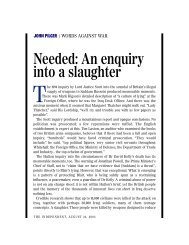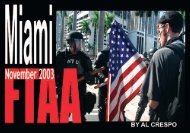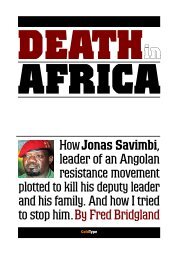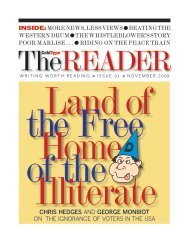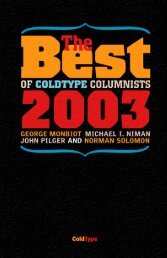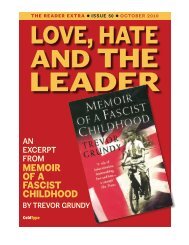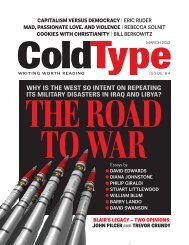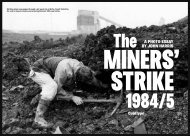UPDATED - ColdType
UPDATED - ColdType
UPDATED - ColdType
- TAGS
- updated
- coldtype
- coldtype.net
You also want an ePaper? Increase the reach of your titles
YUMPU automatically turns print PDFs into web optimized ePapers that Google loves.
statesman overnight.<br />
9/11 provided the opening for rolling out a prepackaged<br />
and orchestrated strategy of deception<br />
and demagoguery, which would be amplified on<br />
the airwaves, endlessly recycled and repeated.<br />
When the decision to go to war was made, in<br />
early September 2002, the media offensive<br />
began. The country was prepared for the<br />
“inevitable” in a rollout that resembled a product<br />
launch. Speech after speech hit the same<br />
themes positioning a strategy of aggression into<br />
a posture of defense and victimization. The<br />
alarmist note was enunciated by the President in<br />
Cincinatti on Oct. 7, 2002, “The Iraqi dictator<br />
must not be permitted to threaten America and<br />
the world with horrible poisons and diseases and<br />
gases and atomic weapons.”<br />
Was America and the world at large ever so<br />
threatened? Were there horrible poisons, and<br />
diseases and gases and atomic weapons just<br />
waiting to be deployed? Were there other<br />
weapons of mass destruction being hidden for<br />
later use? Was there a link between Saddam<br />
Hussein’s secular regime and the 9/11 Islamic<br />
jihad junkies presumably following orders from<br />
Osama bin Laden?<br />
GOVERNMENT MEDIA MANAGEMENT<br />
AS preparations for a war with Iraq moved up on<br />
the Administration’s agenda, plans were made to<br />
sell the story. Journalists were easy prey for<br />
media savvy ideologues in Washington who had<br />
perfected a strategy of perception management,<br />
and knew how to play the media as an orchestra<br />
conductor directs different instruments.<br />
The Administration understood how to get its<br />
message out and did so relentlessly. Corporate<br />
WHAT CAN WE DO ABOUT IT?<br />
247<br />
PR techniques were implanted early on with the<br />
Iraq war “rolled out’ like a product with a multitiered<br />
campaign to sell the policy to the public<br />
through the media. Sheldon Rampton and John<br />
Staunber of PR Watch tell this story in detail in a<br />
new book on “the uses of propaganda in Bush’s<br />
War on Iraq.” Like this one, it is about weapons<br />
of mass deception; only their emphasis is on the<br />
PR campaign and media management techniques<br />
used by the Administration and the Pentagon<br />
through a network of PR firms, think<br />
tanks, lobbying groups, disinformation specialists<br />
military operators and international marketing<br />
efforts. Among their findings:<br />
“ ● Top Bush officials advocated the invasion of<br />
Iraq even before he took office, but waited until<br />
September 2002 to inform the public, through<br />
what the White House termed a “product<br />
launch.”<br />
“ ● White House officials used repetition and<br />
misinformation – the “big lie” tactic – to create<br />
the false impression that Iraq was behind the<br />
September 11th terrorist attacks . . .<br />
“ ● Forged documents were used to “prove”<br />
that Iraq possessed huge stockpiles of banned<br />
weapons.<br />
“ ● A secretive PR firm working for the Pentagon<br />
helped create the Iraqi National Congress<br />
(INC), which became one of the driving forces<br />
behind the decision to go to war.”<br />
From a war fighting perspective, media is now<br />
viewed as a target for IO – Information Operations<br />
– a key component of what military people<br />
call Psy-ops. “Information is the currency of victory,”<br />
says one military manual. Winning the<br />
media war is as important as winning on the<br />
battlefield.<br />
And, hence, the deployment of a well-trained



